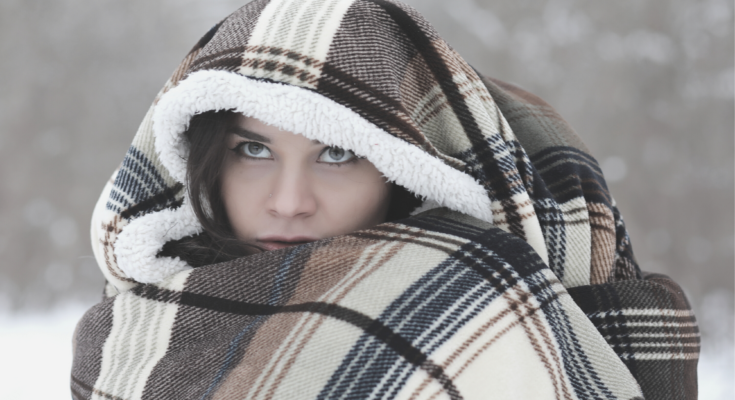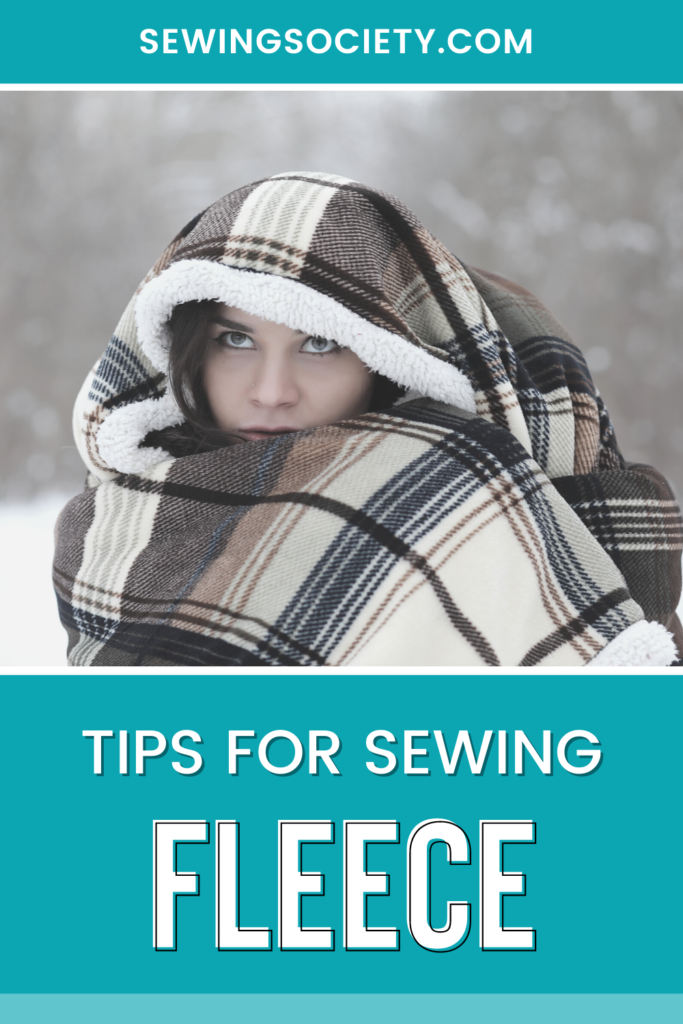Disclosure: This post may contain affiliate links. I earn a small commission when you click a link and make a purchase. Thanks for supporting SewingSociety.com!
I love fleece! It is a durable fabric that is super soft and warm. It comes in different weights, and is commonly used for sleepwear, coats, and blankets.
Fleece is made from synthetic fibers — typically 100% polyester. It is a great fabric because it retains heat and has moisture-wicking properties.
Some people have difficulty sewing with fleece because it has a nap. The thick layers can be tricky, but I have some tips to share to help you sew fleece like a pro.
Preparation and Care of Fleece
Because fleece is a synthetic fabric, it will not shrink when washed. However, you should still wash fleece before sewing it to remove excess dye. Avoid high temperatures, however, as fleece can melt.
With repeated washes, fleece can start to pill — little fuzzies form all over the surface of your fabric. These can be removed with a fabric shaver. You can also buy anti-pill fleece to avoid the problem. ‘Polar fleece’ is the highest quality fleece fabric.
Layout, Marking, and Cutting Tips for Fleece
Fleece has a nap (directional pattern), so pay attention when laying out pattern pieces. Use the “with nap” layout in your pattern. Also, check to be sure the tops of all pattern pieces are facing the same direction before cutting.
Pin pattern pieces to fleece using long, sharp pins, such as quilter’s pins. For thick fleece fabric, pattern weights and a rotary cutter are easier than pinning.
Interfacing is not typically needed when sewing fleece, but if you want to use it to add extra structure, use sew-in interfacing. The pile of fleece fabric can make it difficult to get a strong bond with fusibles.
Sewing Machine Setup for Fleece
You don’t need a special, industrial machine to sew fleece fabric. Just sew slowly and avoid stretching your fabric as you sew.
- Needle: Use a universal needle or a jersey/stretch needle. A size 90/14 or 100/16 needle is best for fleece. A universal needle may not penetrate the thick fabric layers of fleece, leading to broken needles or skipped stitches.
- Presser Foot: A Teflon, zigzag foot helps you glide over the thicknesses of fleece fabric. If the thick layers do not feed evenly, however, a walking foot will solve that problem. Be sure the pressure on your presser foot is adjusted to accommodate the thickness of your fabric, too.
- Stitch Length/Width: Use a long stitch length, between 3.5mm and 4.0mm. Adjust up or down, if needed, after sewing a sample seam on some scraps of your fabric. For stretch fleece, be sure to use a stretch stitch or a narrow zigzag stitch.
Sewing Tips for Fleece
The biggest problem you’ll encounter when sewing fleece is all the lint build up. You’ll need to clean the area around your needle and your bobbin frequently to avoid jamming your machine.
You do not need to finish the raw edges of fleece because they will not fray, but serged seams and welt seams look good. Finished seams also prevent your fleece from curling to the wrong side of your garment.
Double check your work before sewing each step because mistakes are hard to rip out of fleece. Be especially careful with topstitching. The texture and thickness of fleece tends to hide your stitches.
I love to make tie blankets out of fleece. What have you been sewing with this wonderful fabric? Let us know in the comments below.
Share this post on Pinterest!






Several years ago, I made a coat for my dog that has three layers; the top is fleece, the middle is some ugly flannel-backed vinyl that I needed a use for (when I say ugly, I mean Fugly!) and the lining is flannel. It was a little challenging to do, but because I made sure the vinyl was right side up under the fleece, the coat is not only nice and warm, it’s waterproof too. Sadly, the dog I made it for has gone across the rainbow bridge, but our current dog is almost as big so it fits her too. It’s quite sturdy and has held up for over 4 years now. I wash it, dry it for a little while on LOW and hang it while still damp. I think it’s got years in it yet! Ya gotta love fleece!
This article was very helpful to me when sewing my first project, a 3 layer fleece blanket. (2 layers of Sherpa fleece and a layer of Star Wars logo polar fleece). I would like to share that I found a large white chalk marker worked pretty well for marking the fleece, especially the designs I was using for quilting the layers together.
TY for the tips.
Having a bit of a struggle with sewing a flannel lined fleece dog jacket.
Am going to switch to a 14 needle (currently using a 12) and lengthen my stitch a little. Already using a small zig-zag.
Don’t have a walking foot bit do have a roller.
Two questions, tho:
1) Should I loosen both upper and lower tension, and y how much?
2) Sewing w/flannel on top, and it pulls away more from the edge while stitching, so the fleece has a 1/2” seam allowance, but the flannel’s more like 7/16”!!!
Is this a feed problem, or a tension problem?